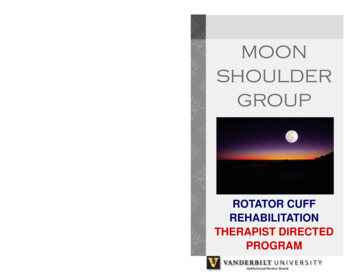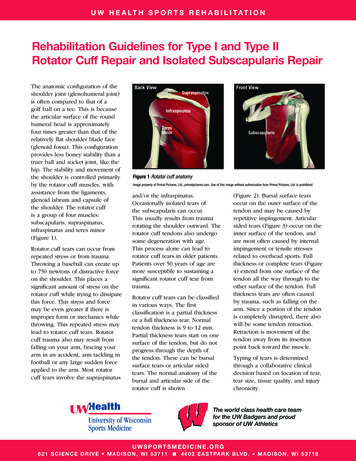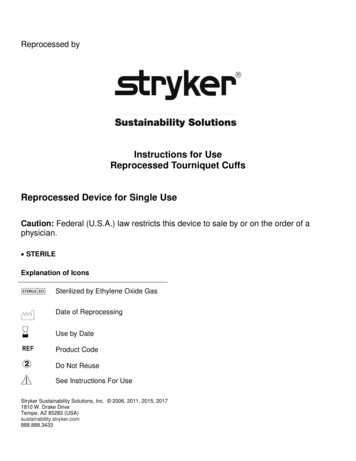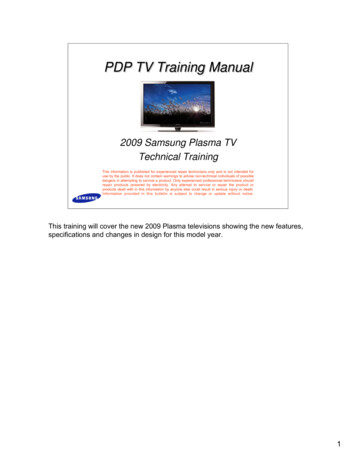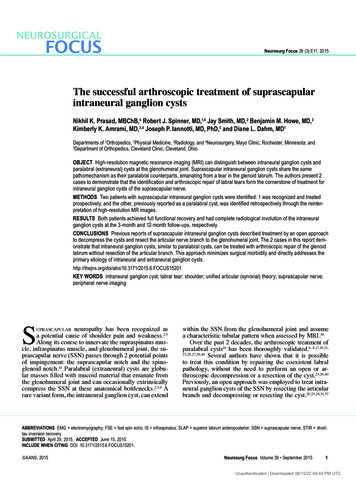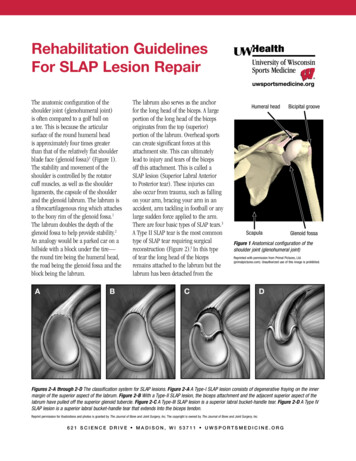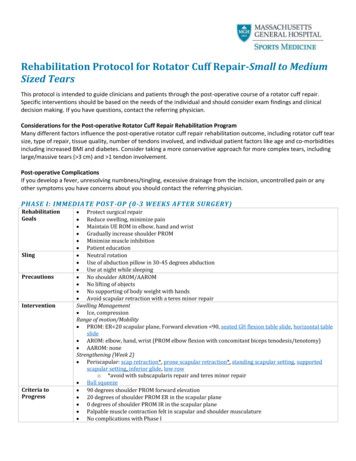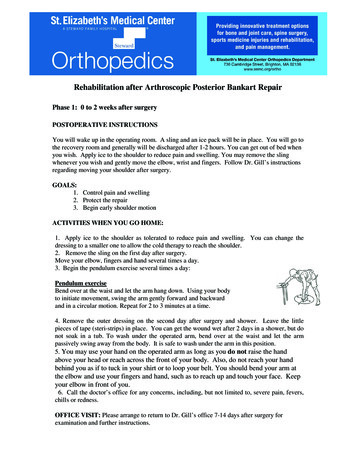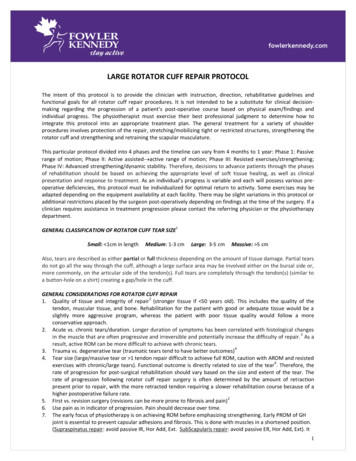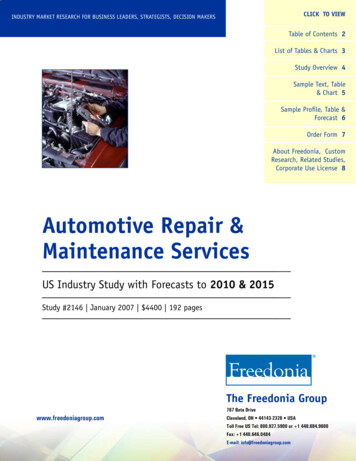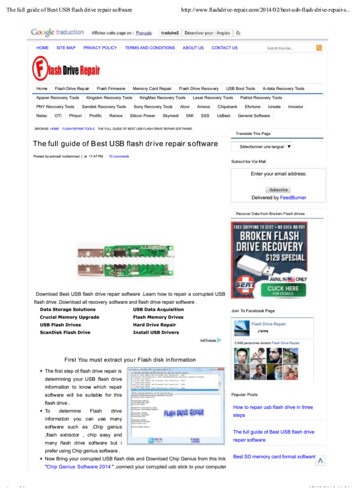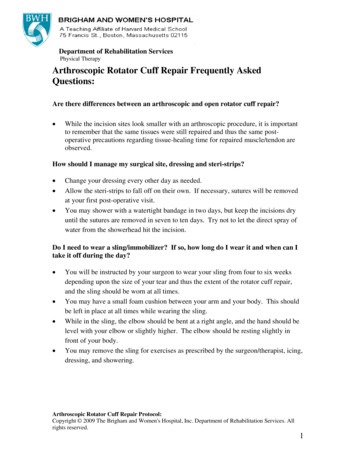
Transcription
Department of Rehabilitation ServicesPhysical TherapyArthroscopic Rotator Cuff Repair Frequently AskedQuestions:Are there differences between an arthroscopic and open rotator cuff repair? While the incision sites look smaller with an arthroscopic procedure, it is importantto remember that the same tissues were still repaired and thus the same postoperative precautions regarding tissue-healing time for repaired muscle/tendon areobserved.How should I manage my surgical site, dressing and steri-strips? Change your dressing every other day as needed.Allow the steri-strips to fall off on their own. If necessary, sutures will be removedat your first post-operative visit.You may shower with a watertight bandage in two days, but keep the incisions dryuntil the sutures are removed in seven to ten days. Try not to let the direct spray ofwater from the showerhead hit the incision.Do I need to wear a sling/immobilizer? If so, how long do I wear it and when can Itake it off during the day? You will be instructed by your surgeon to wear your sling from four to six weeksdepending upon the size of your tear and thus the extent of the rotator cuff repair,and the sling should be worn at all times.You may have a small foam cushion between your arm and your body. This shouldbe left in place at all times while wearing the sling.While in the sling, the elbow should be bent at a right angle, and the hand should belevel with your elbow or slightly higher. The elbow should be resting slightly infront of your body.You may remove the sling for exercises as prescribed by the surgeon/therapist, icing,dressing, and showering.Arthroscopic Rotator Cuff Repair Protocol:Copyright 2009 The Brigham and Women's Hospital, Inc. Department of Rehabilitation Services. Allrights reserved.1
What are my precautions regarding movements and positions after surgery? Whatpositions should I rest my arm in? What positions should I avoid? Do not actively move your arm away from your body for four to six weeks followingsurgery. In addition, do not lift any object even if you are just bending your elbow.Follow your surgeon/therapist’s directions regarding rotating your forearm awayfrom your body to protect repaired tendon and muscles.When lying on your back we recommend you put a towel roll under your elbow tosupport arm.Many patients find that lying on a 30 degree incline wedge in bed is morecomfortable than lying flat. Some patients find sleeping in a recliner morecomfortable during the first few weeks after surgery.Initially after surgery you should not reach behind your back with your operated arm.May I use my involved arm for dressing, bathing, driving, and other daily activities?How should I manage my arm in the shower? You may use your wrist, hand, and elbow for daily activities. This includes eating,shaving, dressing, as long as you do not move your operated arm away from yourbody and it does not increase your pain.Do not use your arm to push up/off the bed or chair for six weeks after your surgery.When using your keyboard and mouse, do not move your arm away from your body.When showering, you may wash under the involved arm pit by bending forward tolet the involved arm hang freely and reaching under with the opposite armDo not actively move your arm away from your body.When should I begin formal physical therapy? How often do I need to go? Physical therapy can usually be initiated within the first six weeks following surgeryand your surgeon will refer you when the time is appropriate. This includesphysical therapy sessions at the clinic, in addition to a home exercise program forrange of motion and postural exercises. You will eventually be prescribedstrengthening exercises. For very large tears, physical therapy may be delayed topromote rotator cuff healing up to 6 weeks postoperatively.Frequency of treatment will be determined by your specific needs together with thephysician and physical therapist recommendations.When may I start strengthening?Arthroscopic Rotator Cuff Repair Protocol:Copyright 2009 The Brigham and Women's Hospital, Inc. Department of Rehabilitation Services. Allrights reserved.2
Typically, strengthening does not begin until twelve weeks after surgery.Are there any medications that I should not take during my recovery/rehabilitation? You should not take any anti-inflammatory (alleve, ibuprofen, and naproxen)medications for at least 12 weeks after surgery as may interfere with tendon healing.You can take Tylenol or any of the pain mediations your surgeon prescribes. Inaddition, the use of frequent (3-4 times per day) icing of your shoulder will assist inpain management.When may I return to sports and recreational activities? Return to sports and recreational activities are specific to the particular activity, butgenerally no sooner than four to six months.Always seek permission from your surgeon and therapist prior to starting any sportsrelated activity.Can I smoke following surgery? You should not smoke after surgery as it interferes with tendon healing.Will I progress just like my friend who had rotator cuff repair surgery? There are many patient specific variables that impact everyone differently. Hence,your recovery is individually based not only on tear size and tissue quality but also ona bell-shaped curve (see below) which takes into account function, relief of pain, andrecovery of power. Typically it will be at least 6 months before you feel real good andyou are ready to return to pre injury/surgery activities. Some individuals take up to 1year before they fully recover.Arthroscopic Rotator Cuff Repair Protocol:Copyright 2009 The Brigham and Women's Hospital, Inc. Department of Rehabilitation Services. Allrights reserved.3
Arthroscopic Rotator Cuff Repair Postoperative Guidelines:The intent of this guideline is to provide both the patient and treating therapist with aframework of the post-operative rehabilitation course following arthroscopicassisted/mini-open rotator cuff repair. It is by no means intended to be a substitute forone’s clinical decision making regarding the progression of a patient’s post-operativecourse based on their physical exam/findings, individual progress, and/or the presence ofpost-operative complications. If a therapist requires assistance in the progression of apost-operative patient they should consult with the referring Surgeon.Progression to the next phase based on Clinical Criteria and/or Time Frames asAppropriate.This protocol is designed for the patient following arthroscopic rotator cuff repair. Thosepatients who have good rotator cuff tissue integrity, a one to two tendon repair, witha tear 3 centimeters or less will typically be progressed on the quicker end of thesetime frames. Those patients with poor rotator cuff tissue integrity, tear of 2complete tendons, and those with a tear ( 3 cm) will need to be progressed at aslower, more conservative rate to respect tissue healing.The scientific basis for postoperative rehabilitation is clear and the recommendationswhich follow take into account the expected timeline for clinical healing based on thisinformation. Many references are available in the literature; however, our recent worksummarizes the available data: Millett, Peter J., Wilcox, Reg B., O’Holleran, James D., Warner, Jon J.P.Rehabilitation of the Rotator Cuff: An Evaluation-Based Approach. Journal of theAAOS. 2006; 14 (11): 599-609.Arthroscopic Rotator Cuff Repair Protocol:Copyright 2009 The Brigham and Women's Hospital, Inc. Department of Rehabilitation Services. Allrights reserved.4
Phase 1: Passive Range of Motion Phase(Post op week # 1 to approximately Post op week # 6)General Information / Goals: This is the “Healing phase”. The strength of the repair is initially only the strengthof the sutures and anchors attaching it to the bone. At 4 weeks post op the strength of the tendon repair is about 20% of a “normal”tendon attachment. Hence, prior to 6 weeks post op no active motion of the arm ispermitted, as it may pull on the repair and disrupt the attachment of the tendon tothe bone. The goal of this phase of recovery is to protect the tendon repair while gentlygaining motion and preventing formation of adhesions (scar tissue) which mightlimit motion. Another goal during this phase is to reduce inflammation and pain. The sling/abduction pillow keeps the arm in a position that takes tension off therepaired tendon.Activities to Avoid: No active range of motion (AROM) of your shoulder, even if you have minimalto no pain or other symptoms. Avoid pushing yourself up from a lying or seated position with your arm. Avoid aggressive and painful passive range of motion (PROM) or stretching thatprovokes muscle guarding / spasm.What you should be doing during this phase: You can go about your normal daily activities around the house and your work aslong as you keep your arm in your sling. We want you to ice your shoulder regularly during this phase 3-4 times per dayfor up to 20 minutes at each session. You can use your cryocuff or an ice pack. Your surgeon will refer you to physical therapy sometime in the first six weeksfollowing your surgery. The timing of the start of your physical therapy will bedetermined by the size of your tear, tissue quality of your rotator cuff, andwhether or not you had any other structures repaired. Your therapist will have you work on activities that enhance the mobility of yourshoulder joint, shoulder blade, elbow, wrist and hand. When lying on your back keep a pillow or towel under your elbow to keep yourupper arm in slight flexion/in line with your trunk. You should always be able tosee your elbow. No shoulder extension at this time. This will also assist withreducing pain. You need to keep your arm in your sling/immobilizer, and remove it only forbathing and your exercises. You may loosen it so that your elbow can straighten(but keep palm up). Immobilization of the shoulder joint is typically up to 4weeks, followed by a gradual weaning from the sling in controlled environmentsArthroscopic Rotator Cuff Repair Protocol:Copyright 2009 The Brigham and Women's Hospital, Inc. Department of Rehabilitation Services. Allrights reserved.5
from your 4th thru 6th weeks following surgery. (Specific timeframes areadjusted based on size of tear, integrity of tissue and repair, and surgeonpreference.)By the end of week 6 you can begin with light waist level activities.You shower with a waterproof dressing 2 days after surgery. Keep your forearmat your side against your hip bone (prevents internal rotation).You may get yourshoulder wet without dressings by your 7th day after surgery.You may sit on a stationary bicycle in order to get some aerobic exercise. Norunning at this point.Once you start therapy:1. You will do your shoulder home exercises up to 3 times per day. Your therapistwill give you guidance regarding frequency of your home exercises based on youroverall shoulder soreness level and your morning discomfort.2. You will typically have in clinic PT appointments 1-3 times per week, dependingupon how your motion is progressing.3. You may use heat prior to therapy and cold (cold therapy unit or ice pack) aftertherapy.4. Your therapist may use some local modalities to assist in reducing pain andinflammation when you are in the PT clinic (i.e. ice, heat, electrical stimulation)5. You will be doing some passive range of motion (PROM) exercises with yourtherapist for your arm at this point. This is where your shoulder muscles arerelaxed and not active. Your therapist may teach a family member of yours toassist you with PROM at home.a. Supine passive elevation range of motion up to 100 degrees. (see nextpage)b. Sitting external rotation up to 30 degrees with external assist (see nextpage).c. No internal rotation at this time.6. All of your initial exercises should be started while you are lying on your back. Inthis position your shoulder blade is well supported and your shoulder muscles aremore relaxed as gravity is minimized. This allows for appropriate range of motionwithout activating your rotator cuff too much.7. You may begin pendulum hangs, but we do not want you to actively move yourarm. (see page 8)8. You should start shoulder blade pinches and rolls. (see page 8)9. PROM for elbow if you had any surgical work done to your biceps tendon(tenodesis or tenotomy)10. Active range of elbow curls if you did not have any surgical work done to yourbiceps. No weight.11. You can begin active exercises for your wrist and hand, including ball squeezes.Arthroscopic Rotator Cuff Repair Protocol:Copyright 2009 The Brigham and Women's Hospital, Inc. Department of Rehabilitation Services. Allrights reserved.6
Passive forward elevation with an assistantYour therapist (or instructed family member) will raise your arm to a certain position over head. Typically 90-100degrees at this stage of recovery. You need to keep your muscles relaxed. Do not force any painful motion. Hold 5-10seconds. Repeat 10-15 times. Eventually your therapist will assist you in gaining further range of motion as in picture2.Self passive elevation on your backLie on your back with your elbow resting on a towel roll and your elbow bent. Use your opposite hand to hold yourwrist or elbow. Keep your operated shoulder muscles relaxed and assist your operative arm straight up. Hold there fora few seconds. Then assist your arm up over your head. Only move through a comfortable range of motion. Initiallyyou will just go to about 90 degrees of motion, as in picture 2 below. Eventually your therapist will advise you to gothrough further range of motion, as in picture 3 below. Hold this position for 2-3 seconds. Return to straight upposition. Hold 2-3 seconds, then bend your elbow and assist yourself back to the starting position with your elbow on atowel roll. Repeat about 10 times.Passive External Rotation with an assistantSitting with a family member sitting beside you; your family member holds your elbow with one hands and your wristwith their other hand. Your thumb should be up and your elbow is at 90 degrees. Your family member will gentlyrotate your arm out to the side until they feel some tightness. Hold 10 seconds then your family member will bringyour arm back to the starting position. Repeat 10 times. You should keep your shoulder muscles relaxed during thisexercise. Typically your family member can rotate your arm up to 30 degrees at this time. Your surgeon or therapistwill let you know when you can rotate your arm out further.Arthroscopic Rotator Cuff Repair Protocol:Copyright 2009 The Brigham and Women's Hospital, Inc. Department of Rehabilitation Services. Allrights reserved.7
Pendulum HangStand holding your kitchen counter with your non involved arm. Place one foot in front of the other. Bend over at thewaist. Gradually let gravity assist your arm to hang straight down. Do not actively use your shoulder muscles. Let yourarm hang up to a minute. Then repeat 10 times.Shoulder Shrugs & Shoulder Blade PinchesStanding with your hand supported with your opposite hand or sitting with your hand supported on your lap gentlyshrug your shoulders upward. Hold 5 seconds and repeat 10 times. Then gently pinch your shoulder blades together asif you were sticking your chest out. Hold 5 seconds and repeat 10 times. You should do these 2 exercises periodicallythough out the day. (You can also do them with your arm resting comfortably in your sling.)ShoulderShrugShoulderBladePinchThings you should achieve before you progress to Phase II: Appropriate healing of surgical repair. Good adherence to precautions and immobilization guidelines. Adequate ROM gained, both in terms of quantity and quality, as determined by yoursurgeon and PT. Typically 120-140 degrees of passive forward elevation and 30-60degrees of passive external rotation with your arm at your side. Inflammation and pain controlled (minimal pain within allowed ROM)Arthroscopic Rotator Cuff Repair Protocol:Copyright 2009 The Brigham and Women's Hospital, Inc. Department of Rehabilitation Services. Allrights reserved.8
Additional therapist instructions, Phase I:First 3 weeks of therapy Patient education: posture, joint protection, positioning, and hygiene Pendulum hangs, no active movement of shoulder Elbow, wrist, and hand active range of motion (AROM), no weightso Only PROM of elbow if concomitant biceps tenodesis/tenotomy performed. Passive forward elevation (PFE) in the plane of scapula to 90 -100 degrees Passive external rotation (PER) with elbow ‘near’ the side of the body to 30 degrees. May beadjusted base on location of the tear and intraoperatively determined ‘safe zone’ of ER. Early PROM activities should include only those activities with low RC EMG activity. (i.e. nopulleys, cane ther ex, or self PROM at this time.) Begin active and manual scapula strengthening exercisesWeeks 3 and 4 of therapy Progress Pendulum Hangs to Pendulum mobility, discomfort to be the guide Progress scapula strengthening Progress PFE and PER to tolerance May begin joint mobilizations grade I & II for pain relief / relaxation as indicated for allshoulder girdle joints (GH, SC, AC, ST) May allow aquatic therapy for active assisted range of motion (AAROM), if incisions wellhealed, no swimming strokes.Additional recommendations regarding pain/inflammation management: Activity modification/restriction Proper use of sling Scar management Modalities PRN MD prescribed or over the counter medicationso We do not advise NSAIDS for at least 12 weeks post operatively, as it may diminishhealing of the rotator cuff. (This is currently being investigated)Arthroscopic Rotator Cuff Repair Protocol:Copyright 2009 The Brigham and Women's Hospital, Inc. Department of Rehabilitation Services. Allrights reserved.9
Phase II: Active Range of Motion Phase(Approximately postop week 6 to post op week 12)General Information / Goals: You still need to allow for healing. After 4 weeks postop the tendon repair isgreater than 20% of a normal shoulder which is sufficient to allow you to doassisted and active motion. This is the “active range of motion” period. Wewant you to normalize your motion and activities of daily living during thisperiod. After 8 weeks the tendon will be about 40% as strong as a normal tendon. After 12 weeks the tendon is 60% as strong as a normal tendon.Activities to Avoid: No lifting or activities that require ROM beyond what you can do comfortably No supporting of body weight by hands and arms No excessive behind the back movements No sudden jerking motionsWhat you should be doing during this phase:1. You can actively use of your arm for daily living: bathing, dressing, driving,typing on a computer, eating and drinking2. No lifting anything heavier than a cup of water3. You may use an elliptical machine but do not support your body weight withyour operated arm. No running yet.4. You will do your shoulder home exercises up to 2 times per day. Yourtherapist will give you guidance regarding frequency of your home exercisesbased on your overall shoulder soreness level and your morning discomfort.5. You will typically have in clinic PT appointments 1-3 times per week,depending upon how your motion is progressing.6. You may use heat prior to therapy and cold (cold therapy unit) after therapy.7. Your therapist may use some local modalities to assist in reducing pain andinflammation when you are in the PT clinic (i.e. electrical stimulation)8. Your therapist will help you with supine passive range of motion (Pillowbehind elbow keeps arm in slight flexion. No extension permitted):a. Forward Elevation: to toleranceb. External rotation, at multiple angles: to tolerancec. Scapular plane abduction: to tolerance9. Water (pool) therapy (if available):a. Standing in water with float under arm, lower body into water to helpstretch into flexionb. Standing in water with float under arm, lower body to side to help withexternal rotationArthroscopic Rotator Cuff Repair Protocol:Copyright 2009 The Brigham and Women's Hospital, Inc. Department of Rehabilitation Services. Allrights reserved.10
10. Active-assisted range of motion exercises, typically starts by 6 weeks postop(see examples below)a. Elevation: lying on your back, then sitting, then standingAssisted elevation on your backThis is very similar to your previous self passive elevation exercise. However, you can now do a little of the work withyour operated shoulder muscles as discomfort allows. Lie on your back with your elbow resting on a towel roll andyour elbow bent. Use your opposite hand to hold your elbow or wrist. Assist your operative arm straight (see below).Hold there for a few seconds. Then assist your arm up over your head. Only move through a comfortable range ofmotion. Hold this position for 2-3 seconds. Return to straight up position. Hold 2-3 seconds, then bend your elbowand assist yourself back to the starting position with your elbow on a towel roll. Repeat about 10 times. When thisbecomes easy progress to doing it with a cane, then a small towel, and then without assist (see pictures below).With opposite arm assistWith cane assistWith towel assistWithout assistArthroscopic Rotator Cuff Repair Protocol:Copyright 2009 The Brigham and Women's Hospital, Inc. Department of Rehabilitation Services. Allrights reserved.11
Sitting assisted forward reachYou will progress to this when the previous exercises on your back have become easy. Sitting in a chair at yourkitchen table place a towel under your hand. Gently slide the towel forward as if you were dusting the table. Reach acomfortable distance slowly. Hold 2-3 seconds, and then return to the starting position. Then repeat about 10 times.When this becomes easy then do the same motion/exercise without the table and towel. You can do it either sitting orstanding.Sitting or standing unassisted forward reachStanding assisted elevationThis can be done a few different ways. You could use a cane, your opposite hand, and/or a pillowcase and the wall.Your therapist will assist you in determining when you should start these exercises and which one is best for you. Youshould not force any painful motion and you must do these exercises with good mechanics without cheating with yourneck or back muscles. Start with your arm at your side and thumb upward. Use the cane, opposite hand or pillowcase& wall to assist your arm to a comfortable end elevation range of motion, hold 2-3 seconds and then slowly returnyour arm to your side. Repeat 10 times.Arthroscopic Rotator Cuff Repair Protocol:Copyright 2009 The Brigham and Women's Hospital, Inc. Department of Rehabilitation Services. Allrights reserved.12
Assisted Externalrotation with a caneSitting and lying on yourback with your elbowresting on a towel andyour elbow bent to 90degrees. Use a cane inthe opposite hand toassist your operated armto rotate outwards. Hold10 seconds, relax, thenrepeat up to 15 times.Your therapist willadvise you whichposition(s) and how farto go for your shoulderbased on the specifics ofyour tear and repair.b. External rotation: on your back, sitting, standing (multiple angles)Assisted external rotation standingBend your elbow to 90 degrees. Rest your forearm on a pillow on your kitchen counter. Your elbow should be restingcomfortably at your side. Keep your arm still and gently take some small steps with your feet to rotate your body awayfrom your arm till you feel a comfortable stretch. Your therapist will advise you how far you should go. Do not forceany painful motion. Hold 10-20 seconds, and then take small steps to rotate your body back toward your arm. Rest,and then repeat 10 times.c. Pendulum mobility exercisePendulumsBend over at the waist and letyour arm hand down. Usingyour body to initiate themotion, swing the arm gentlyforward and backward in acircular motion.Arthroscopic Rotator Cuff Repair Protocol:Copyright 2009 The Brigham and Women's Hospital, Inc. Department of Rehabilitation Services. Allrights reserved.13
11. Active range of motion, typically 6-8 weeks postop (see below)a. Forward elevation in the plane of the scapulab. External rotation, multiple positions and anglesabbActive Range of Motion Exercises (pictures above)(a) Full can exercise – Standing facing a mirror with your thumb upward/forward. Keep yourshoulder blade ‘set’ and your elbow straight, raise your arm forward and upward with a slight20 degree outward angle. Hold for 3 seconds then slowly lower and repeat.(b) External rotation exercises – With your elbow supported (either on your waist with a towel oron your kitchen table) rotate your arm out to the side as far as you can. Hold for 3 seconds thenslowly return your arm to the starting position.(c) Your therapist will progress you to other active range of motion exercises in other planes ofmovement when your shoulder is ready to begin these (i.e. pure flexion, pure abduction, crossbody adduction, etc.)12. When appropriate (i.e. good AROM mechanics and pain free) initiate basestrengthening program for deltoid, non repaired segments of the rotator cuff, and scapulamusculature. Typically 10-12 weeks post op for small tears, delayed up to 16 weeksfor large to massive tears. Light resistive band exercises in pain free range of motion (see next page) Scapula strengthening program Begin low level closed chain programThings you should achieve before you progress to Phase III: Adequate ROM in all planes without pain or substitution patterns, as determinedby your MD and PT. Typically greater than 140 degrees of passive forwardelevation, greater than 115 degrees of active forward elevation, normal externalrotation at 0 degrees of abduction. Appropriate shoulder blade positioning at rest and with shoulder activity. Completion of current rehabilitation program / exercise without pain or difficulty. Minimal pain.External Rotation StrengtheningArthroscopic Rotator Cuff Repair Protocol:Copyright 2009 The Brigham and Women's Hospital, Inc. Department of Rehabilitation Services. Allrights reserved.14
Tie band around sturdy object or close it in a door at about the height of your elbow. Place a small towel roll underyour elbow if instructed by your therapist. Hold the band as starting position picture shows. Keep your shoulders backand your elbow bent at 90 degrees as you slowly rotate your forearm away from your stomach. Move to the end ofyour comfortable range of motion. Hold this position for 2-3 seconds. Return to starting position and repeat for 3 setsof 10-15 repetitions (up to 30 to 45 reps total). Your therapist may show you an alternative method of doing thisexercise with a pulley and light weight.Internal Rotation StrengtheningTie band around sturdy object or close it in a door at about the height of your elbow. Place a small towel roll underyour elbow if instructed by your therapist. Hold the band as starting position picture shows. Keep your shoulders backand your elbow bent at 90 degrees as you slowly rotate your forearm towards your stomach. Move to the end of yourcomfortable range of motion. Hold this position for 2-3 seconds. Return to starting position and repeat for 3 sets of10-15 repetitions (up to 30 to 45 reps total) Your therapist may show you an alternative method of doing this exercisewith a pulley and light weight.Row with Resistance BandStart with band tied around sturdy object or close it in a door. Begin with your shoulder blades back and your armsextended. Keep shoulder blades squeezed together as you pull the band back as shown. Don’t let your elbows gobehind your body. Hold 2-3 seconds and return to starting position. Repeat 3 sets of 10-15 repetitions (up to 30 to 45reps total) Your therapist may show you an alternative method of doing this exercise with a pulley and light weight.Rowing alternativesIf appropriate for you, your therapist will show yousome additional exercises with resistance band forupper back strengthening. ‘W’s ‘T’s ‘Y’s ‘I’sArthroscopic Rotator Cuff Repair Protocol:Copyright 2009 The Brigham and Women's Hospital, Inc. Department of Rehabilitation Services. Allrights reserved.15
Rotator Cuff StretchingThe intensity and frequency of stretching that one needs is variable. Your surgeon and therapistwill advise you which stretches and how intense you should stretch based on how your shoulder isprogressing.Behind the back internal rotationStanding, place your operated arm behind you at the waistline. Use your opposite hand to assist your hand highertowards your shoulder blade. Hold this position for 10-30 seconds. Return to starting position and repeat for up to 10times. Your therapist will advise you if you need to be more aggressive with this stretch and use a towel.Sidelying internal rotation stretchLie on your side with your arm positioned so that the arm is at a right angle to your body and the elbow is bent to 90degrees. Keeping the elbow at a right angle, rotate your arm forward as if you were going to touch the table with yourpalm. Apply a gentle stretch. Hold this position for 10-30 seconds. Return to starting position and repeat for up to 10times.Cross body stretchThis can be done standing, standing leaning against a wall or lying on your back. Support your elbow with youropposite hand/arm. Gently bring your elbow toward the opposite shoulder across your body. Hold this position for 1030 seconds. Return to starting position and repeat for up to 10 times.Arthroscopic Rotator Cuff Repair Protocol:Copyright 2009 The Brigham and Women's Hospital, Inc. Department of Rehabilitation Services. Allrights reserved.16
Doorway external rotation stretchThis is done standing. Bend your elbow to 90 degrees. Place your hand on a door frame or outward corner in yourhome. Your elbow should be comfortably placed at your side. Keep your arm still and gently take some small stepswith your feet to rotate your body away from
medications for at least 12 weeks after surgery as may interfere with tendon healing. You can take Tylenol or any of the pain mediations your surgeon prescribes. In addition, the use of frequent (3-4 times per day) icing of your shoulder will assist in pain management. When may I return to sports and recreational activities?
